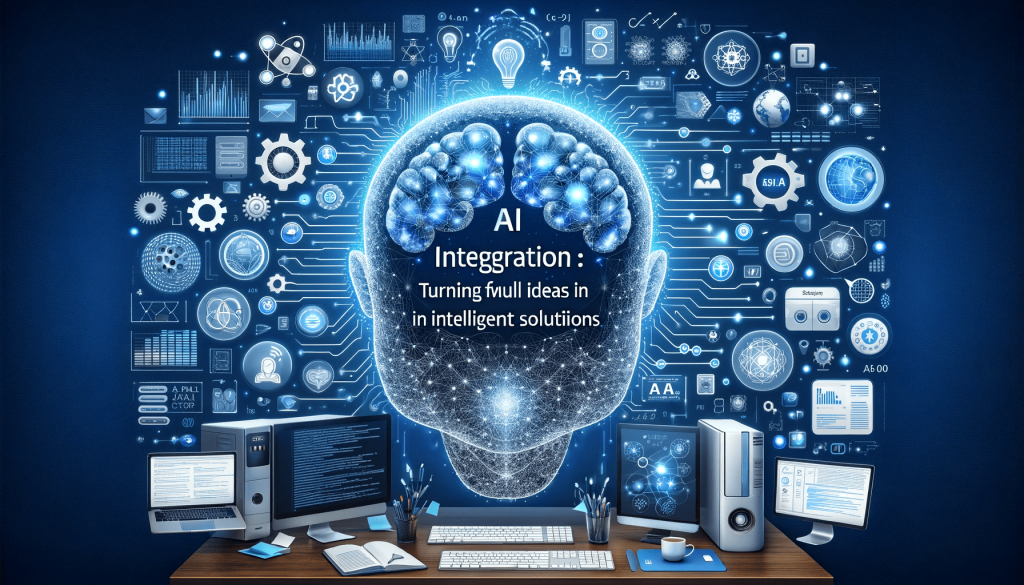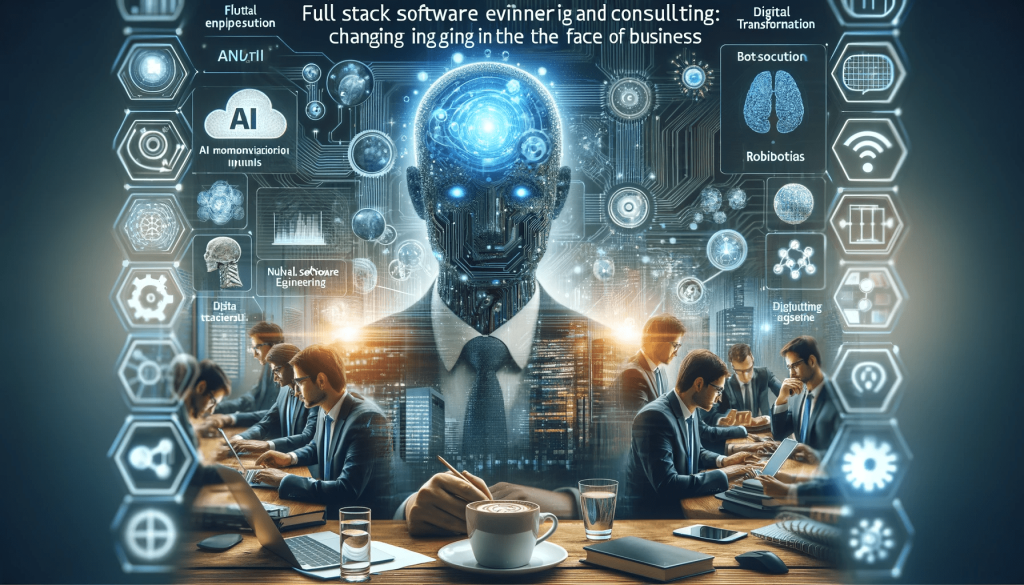AI Integration in Software: Turning Ideas into Intelligent Solutions

The advent of artificial intelligence (AI) has revolutionized various industries, transforming how businesses operate and interact with their customers. Integrating AI into software solutions offers unprecedented opportunities to enhance automation, predict trends, and deliver superior user experiences. This blog post delves into the transformative potential of AI integration, providing a comprehensive guide for businesses looking to harness AI to turn innovative ideas into intelligent solutions.
Introduction
In an era where technology evolves at lightning speed, businesses must innovate continuously to stay ahead. AI integration in software development has emerged as a game-changer, enabling companies to automate complex tasks, gain insights from vast datasets, and create personalized user experiences. By leveraging AI, businesses can unlock new efficiencies, drive growth, and maintain a competitive edge in the market. This post explores the process of AI integration, from identifying opportunities to deploying and monitoring AI solutions, offering valuable insights and practical advice for successful implementation.
Overview of AI
AI refers to the simulation of human intelligence in machines that are programmed to think, learn, and make decisions. Key AI technologies include:
- Machine Learning (ML): Algorithms that enable computers to learn from data and improve performance over time without explicit programming.
- Natural Language Processing (NLP): Techniques that allow machines to understand, interpret, and generate human language.
- Computer Vision: Methods for enabling machines to interpret and make decisions based on visual data from the world.
AI’s significance in software development continues to grow as these technologies become more advanced and accessible. AI-driven solutions are now integral to various applications, from automated customer service to predictive analytics and beyond.
Process of AI Integration in Software Development
Identifying AI Opportunities
The first step in AI integration is recognizing areas where AI can add value. Key opportunities include:
- Automation: Streamlining repetitive tasks to enhance efficiency.
- Predictive Analytics: Analyzing data to forecast trends and make informed decisions.
- Enhanced User Experiences: Personalizing interactions and providing intelligent assistance.
Examples:
- Customer Service Chatbots: Using NLP to handle customer queries and provide instant support.
- Recommendation Systems: Leveraging ML to suggest products or content based on user behavior.
- Fraud Detection: Implementing AI to identify and prevent fraudulent activities in real-time.
Planning and Strategy
A strategic approach is crucial for successful AI integration. This involves aligning AI initiatives with business goals, creating a roadmap, and defining success metrics.
Steps:
- Stakeholder Engagement: Involve key stakeholders to ensure alignment and buy-in.
- Resource Allocation: Allocate necessary resources, including budget, talent, and technology.
- Defining Success Metrics: Establish clear metrics to measure the impact of AI initiatives.
Selecting the Right AI Technologies
Choosing the appropriate AI tools and platforms is critical for project success. Popular AI platforms include:
- TensorFlow: An open-source ML framework by Google.
- PyTorch: An open-source ML library developed by Facebook.
- IBM Watson: A suite of AI services and applications by IBM.
- Google AI Platform: A cloud-based platform for building and deploying AI models.
Criteria:
- Project Requirements: Ensure the chosen technology meets the specific needs of your project.
- Scalability: Select tools that can scale with your growing data and user base.
- Existing Infrastructure: Consider compatibility with your current systems and infrastructure.
Data Collection and Preparation
Data is the backbone of AI projects. High-quality data is essential for training accurate and reliable models.
Methods:
- Gathering Relevant Data: Collect data from various sources, ensuring it is relevant and comprehensive.
- Data Cleaning and Preprocessing: Remove inaccuracies and inconsistencies to create a clean dataset.
- Data Augmentation: Enhance the dataset by adding variations to improve model robustness.
Ethical Considerations:
- Data Privacy: Ensure compliance with data protection regulations.
- Ethical Use: Use data responsibly, avoiding biases and ensuring fairness.
Model Development and Training
Building and training AI models involves several steps:
- Selecting Algorithms: Choose algorithms that best suit your problem (e.g., regression, classification, clustering).
- Tuning Hyperparameters: Optimize model performance by adjusting hyperparameters.
- Validating Models: Ensure model accuracy and reliability through cross-validation and testing.
Examples:
- Regression Models: Predicting continuous values, such as sales forecasts.
- Classification Models: Categorizing data into predefined classes, such as spam detection.
- Clustering Models: Grouping similar data points, such as customer segmentation.
Integration with Existing Systems
Seamless integration of AI models into existing software systems is essential for maximizing their value.
Strategies:
- APIs: Use APIs to enable communication between AI components and other software modules.
- Microservices: Deploy AI models as microservices for modular and scalable integration.
Deployment and Monitoring
Deploying AI models into production requires careful planning and continuous monitoring.
Best Practices:
- Containerization: Use containers (e.g., Docker) to ensure consistent deployment environments.
- CI/CD Pipelines: Implement CI/CD pipelines for automated testing and deployment.
- Monitoring Performance: Continuously monitor model performance and retrain as necessary to maintain accuracy.
User Experience and Interface Design
Designing intuitive user interfaces is crucial for the successful adoption of AI-powered applications.
Examples:
- Voice Assistants: Providing voice-enabled interactions for hands-free operation.
- Interactive Dashboards: Offering visual insights and data-driven recommendations.
Real-World Case Studies
Case Study 1: Retail Industry
A leading retailer implemented an AI-powered recommendation system to personalize the shopping experience. By analyzing customer behavior and preferences, the system provided tailored product suggestions, resulting in a 20% increase in sales and improved customer satisfaction.
Case Study 2: Healthcare Sector
A healthcare provider integrated AI for predictive analytics to anticipate patient needs and optimize resource allocation. The AI system analyzed patient data to predict hospital admissions, reducing wait times and improving patient care outcomes.
Challenges and Considerations
Technical Challenges
- Scalability: Ensuring AI models can handle large datasets and high user traffic.
- Computational Resources: Managing the computational power required for training and deploying AI models.
- Integration Complexity: Addressing the complexity of integrating AI into existing systems.
Ethical and Legal Considerations
- Responsible AI Use: Ensuring AI applications are ethical and transparent.
- Data Privacy: Complying with data protection laws and safeguarding user data.
- Regulatory Compliance: Adhering to industry-specific regulations and standards.
Skill Gaps
Bridging the gap between current workforce skills and AI expertise is essential for successful integration.
Solutions:
- Training Programs: Invest in training programs to upskill employees.
- Hiring Experts: Recruit AI specialists to bring in the necessary expertise.
- Collaborating with Experts: Partner with AI vendors, consultants, and research institutions for guidance and support.
Practical Tips and Best Practices
- Investing in Talent: Build or acquire the necessary AI expertise within your organization.
- Collaborating with AI Experts: Partner with AI vendors, consultants, and research institutions for guidance and support.
- Fostering a Culture of Innovation: Encourage experimentation and continuous learning within the development team.
Resources for Further Learning
For those looking to deepen their understanding of AI integration, consider the following resources:
- Articles: “Artificial Intelligence: A Modern Approach” by Stuart Russell and Peter Norvig.
- Courses: “Machine Learning” by Andrew Ng on Coursera, “Deep Learning Specialization” on Coursera.
- Tools: TensorFlow, PyTorch, IBM Watson, Google AI Platform.
- Communities: Join AI communities and forums such as AI Alignment Forum, Machine Learning Mastery, and local AI meetups.
Conclusion
AI integration in software development holds the potential to transform innovative ideas into intelligent solutions that drive business success. By following the strategies and best practices outlined in this post, businesses can effectively harness AI to automate processes, enhance user experiences, and gain valuable insights. As AI technologies continue to evolve, embracing AI integration will be key to staying competitive and achieving long-term growth. Consider embarking on your AI journey today and unlock the transformative power of artificial intelligence.
By embracing AI integration, businesses can turn visionary ideas into intelligent solutions, driving innovation and achieving significant competitive advantages. Whether you’re a technical professional or a business leader, the insights and practical advice provided in this post can guide you in leveraging AI to transform your software development processes and deliver exceptional value to your customers.






 and then
and then
Responses